Unless you’re a resident of the Hispanosphere, you may not realize that July 12 is the inaugural National Aguardiente Day. In fact, you may not be familiar with it at all. Although it had its origins in Spain and Portugal, aguardiente production is flourishing in locations as diverse as Cape Verde, Chile, Colombia, Costa Rica, Ecuador, Guam, Peru, Panama, Bolivia, Brazil (where it competes with cachaça) and Mexico, where it takes a back seat to both tequila and mezcal.
Aguardiente is a spirit first fermented and then distilled from either fruits, grains, or tubers, but the authentic version is made from sugarcane. In Spain and Portugal, the spirit has protected designations of origins, while regulations in the rest of the countries vary widely. Unlike Scotch, bourbon, brandy, Cognac and certain types of cachaça, it is served clear rather than being aged in barrels. And of course, there is undoubtedly a great deal of homemade moonshine out there. It has probably reached its apex of popularity in Colombia, where it is regarded as the national spirit.
Let’s dispense with the myths of aguardiente:
Aguardiente is more potent than other liquors: Not so. Even though the name literally translates as “firewater,” alcohol levels are similar to other drinks, and sometimes lower (24-29% in Colombia). In many countries, the ABV hovers around 35-40%, or the same as most bottled spirits. In a few cases it can rise to 60%, equivalent to a barrel-strength bourbon.
Aguardiente can cause blindness: Any homemade spirit can cause blindness or death, if the distiller isn’t skilled enough to control the methanol levels. If your mother never told you not to drink moonshine, take that advice from me.
Aguardiente is (or should be) cheap: To some people, the term means lower in price than the competition; to others, it signifies an inferior product. While a typical bottle will cost less than single malt Scotch or bourbon, this is not always the case (as we’ll see in a moment). Like most things in life, you generally get what you pay for.
Aguardiente is an aphrodisiac: Good luck with that. Consuming alcohol lowers inhibition levels, of course, but it’s not Viagra.
In Colombia, aguardiente is more than a drink: It is a cultural icon, an emblem of national identity, and more popular than either rum or whiskey. It was probably brought to the country by Spanish settlers, who had mastered the art of distillation. The epicenter of production is the Andean region, where each area has its own traditional variation. Regardless of any differences, the essential components are sugar cane, alcohol, water and star anise (in Colombia, it is usually not sweetened). The anise flavoring is a distinctive characteristic of the Colombian version.
If you’ve read this far, you’re probably wondering about Bacan Guaro. The brand was created by the Colombian entrepreneur Diana Espinosa March and her Italian/Spanish husband, Ricardo March. From their base in Miami (speaking of the Hispanosphere), the couple spent several years experimenting with organic ingredients to concoct a super-premium aguardiente that would appeal to a worldwide audience. Rather than being consumed by the shot, the goal is to provide an upscale drink that can be enjoyed neat, over ice, or in cocktails. In addition to winning more awards than any other spirit of its type, Bacan Guaro is sugar-free, low in calories, vegan and kosher.
Two expressions are offered in 700 ml bottles at $49.99: Bacan 24 (48 proof, 24% alcohol) and Bacan 29 (58 proof, 29% alcohol). Both versions are crafted in small batches using first-press organic sugarcane juice, organic Spanish star anise, and water. For those who want to compare them, a discovery box containing 200 ml bottles of each is available for $34.99.
The nose of the Bacan Guaro 24 exudes a faint aroma of anise and a strong mineral underpinning. It enters the mouth softly and sweetly, but gives way in the midpalate to black pepper and floral notes, and finishes long with a slightly spicy edge. The bouquet of the Bacan Guaro 29 is similar but more complex, infused with an assortment of fresh herb aromas along with the anise, mineral and black pepper accents. The entry is even sweeter than the 24, and it coats the mouth with an unctuous texture that borders on luxurious; the finish is clean, calm and gentle. The extra 5% alcohol isn’t noticeable by itself but lends elegance and generosity to the spirit that makes it delightful to sip on its own.
Full disclosure: I have a strong aversion to the taste and smell of anise, having gotten sick on licorice as a child. Even so, I had no problem appreciating either of them. All the elements of both spirits were carefully balanced and integrated.
Is the world ready for a super-premium aguardiente? The best answer is probably why not? Given the global gentrification of spirits over the past three or four decades, stranger things have happened. Remember that small batch and single barrel bourbon didn’t exist until the mid-1980s, that super-premium tequila only appeared in the 1990s, and that most vodka was considered to be more or less the same until Grey Goose came along. It will be interesting to see if Bacan Guaro becomes the forerunner of a trend. Sometimes, we don’t know what we want until we have it.
Here are some of the more interesting aguardiente cocktails:
Guarorita Pa’ Ahorita (Guarorita for Now)
Created by Gabe Urrutia
Ingredients:
2.0 oz Bacan Guaro 24
1.0 oz lime juice
0.5 oz Ancho Reyes Verde
0.5 oz real mango purée
0.5 oz agave nectar
Tajin spice
Method:
Prepare a double rocks glass with a Tajín rim.
Shake all ingredients with ice until well chilled.
Strain into the prepared glass over fresh ice.
Garnish with a dehydrated lime wheel (optional) and a mango slice sprinkled with Tajín.
Guaro Lychee
Created by Miguel Angel Martinez
Ingredients:
2.0 oz Bacan Guaro 29
1.0 oz lime juice
1.0 oz simple syrup
1.5 oz lychee water
3 mint leaves
Tonic water
Method:
Prepare a wine glass with ice.
Shake all ingredients (except tonic water) with ice.
Double strain into the prepared glass.
Top with tonic water.
Garnish with lychee nuts and a mint sprig on a cocktail pick.
Viva La Vida
Created by Gabe Urrutia
Ingredients:
2.0 oz Bacan Guaro 29
0.75 oz lemon juice
0.75 oz hibiscus syrup
2 dashes rose water
Method:
Fill a stemless flute or Collins glass with ice.
Pour all ingredients into the glass and stir well.
Garnish with a lime twist and edible flowers.
Chimberito
Served at the Michelin-starred El Cielo in Miami, FL
Ingredients:
2.0 oz Bacan Guaro 29
1.5 oz soursop juice
0.5 oz thyme syrup
0.5 oz yuzu juice
Method:
Add all the ingredients to a shaker with ice.
Shake well until chilled.
Strain into a stemmed glass rimmed with citrus salt.
Garnish with a sprig of fresh thyme.
Bacanccino
Ingredients:
1.75 oz Bacan Guaro 24
3.0 oz espresso (cooled)
0.5 oz white chocolate syrup
Method:
Add Bacan Guaro 24, cooled espresso, and white chocolate syrup to a shaker with ice.
Shake well until cold.
Strain into a coupe glass.
Garnish with grated dark chocolate

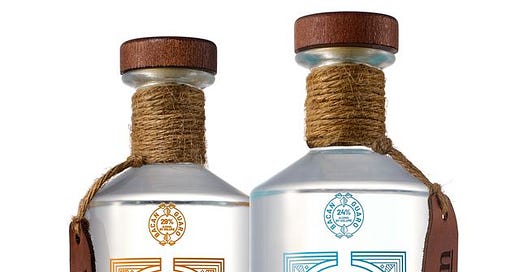



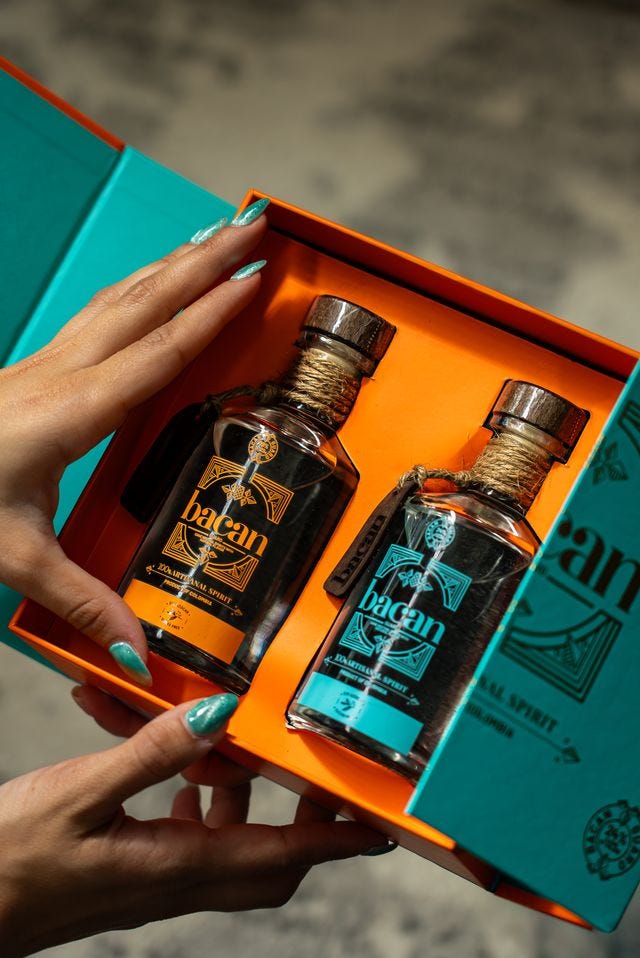

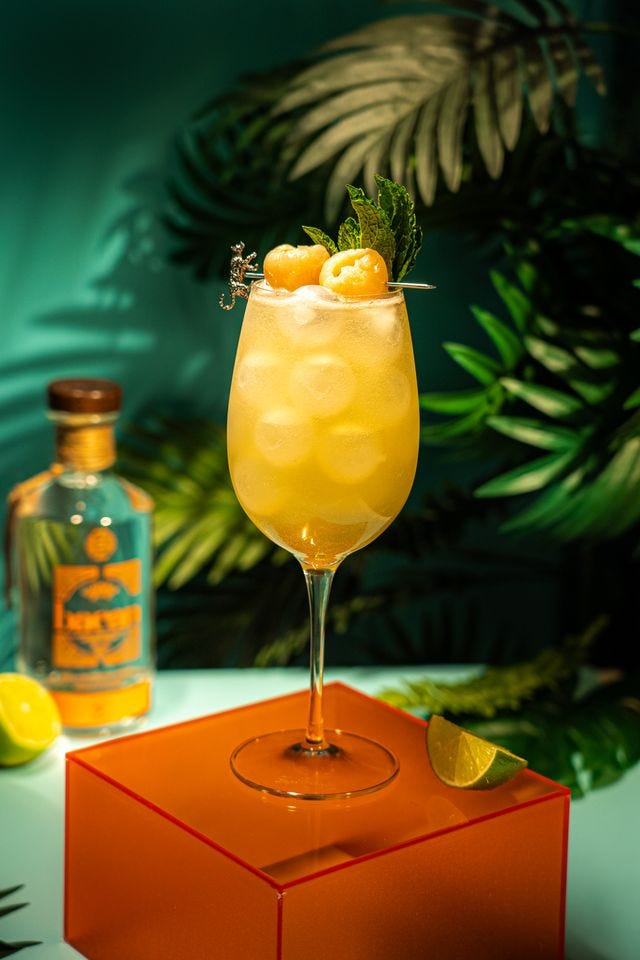
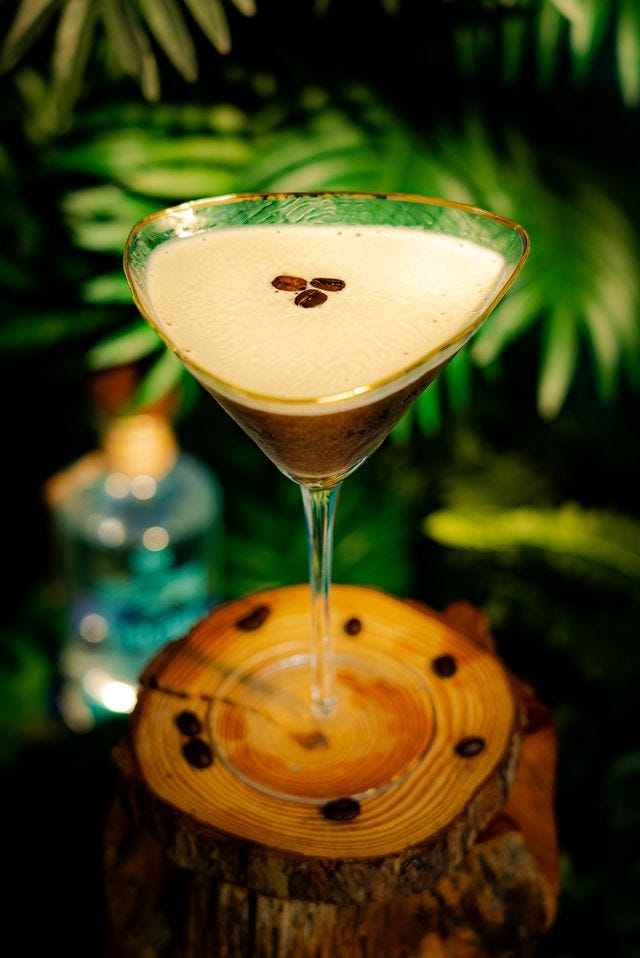
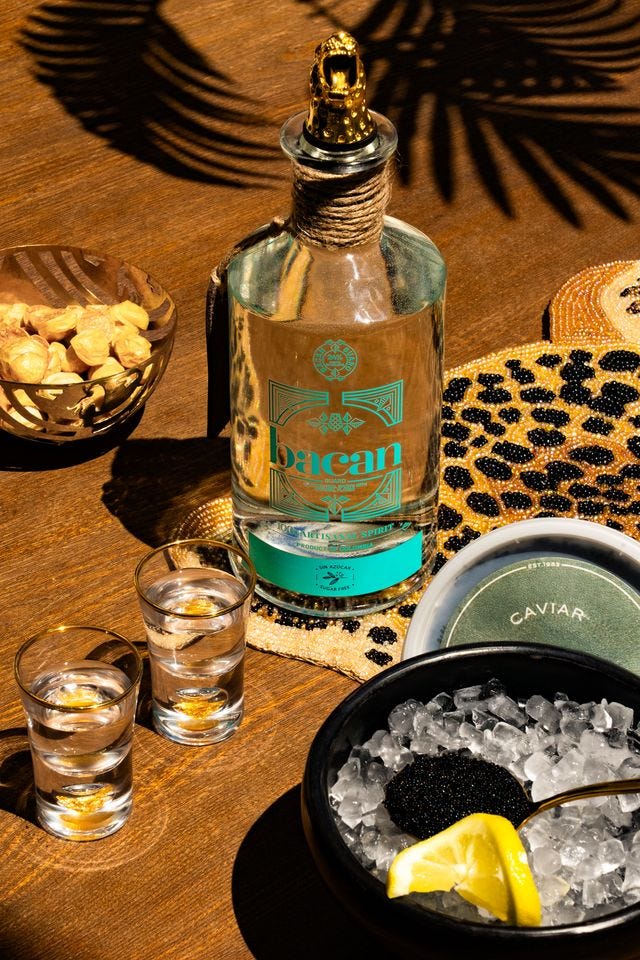
So where does orujo (which l love) fit in? I always thought it was a kind of aguardiente, or that they were the same thing with different names, but now I’m confused because orujo is made from pomace, not sugar cane. Is it more related to grappa? Is grappa an aguardiente? Help??